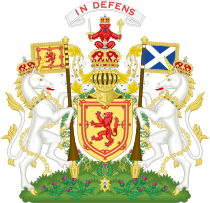Royal Scottish Navy
| Royal Scots Navy Ryal Scots Navy (RSN) |
|
|---|---|

|
|
| Active | Middle Ages–1707 |
| Disbanded | 1 May 1707 |
| Country |
|
| Allegiance | Monarch of Scotland |
| Type | Navy |
| Role | Coastal defence |
| Part of | Scottish Military |
| Motto(s) |
In My Defens God Me Defend ("In My Defence God Me Defend") |
| Colours | Blue, White, & Red |
| Engagements | |
| Commanders | |
| Lord High Admiral | David Wemyss (last) |
| Insignia | |
| Red Ensign (until 1707) |  |
The Royal Scots Navy (or Old Scots Navy) was the navy of the Kingdom of Scotland from its origins in the Middle Ages until its merger with the Kingdom of England's Royal Navy per the Acts of Union 1707. There are mentions in Medieval records of fleets commanded by Scottish kings in the twelfth and thirteenth centuries. Robert I developed naval power to counter the English in the Wars of Independence and after the establishment of Scottish independence continued to build up naval capacity. In the late fourteenth century naval warfare with England was conducted largely by hired Scots, Flemish and French merchantmen and privateers. James I took a greater interest in naval power establishing a shipbuilding yard at Leith and probably created the office of Lord High Admiral.
James IV put the enterprise on a new footing, founding a harbour at Newhaven and a dockyard at the Pools of Airth. He acquired a total of 38 ships including the Great Michael, at that time, the largest ship in Europe. Scottish ships had some success against privateers, accompanied the king on his expeditions in the islands and intervened in conflicts in Scandinavia and the Baltic, but were sold after the Flodden campaign. Thereafter Scottish naval efforts would rely on privateering captains and hired merchantmen. Despite truces between England and Scotland there were periodic outbreaks of a guerre de course. James V built a new harbour at Burntisland in 1542. The chief use of naval power in his reign were a series of expeditions to the Isles and France.
...
Wikipedia
